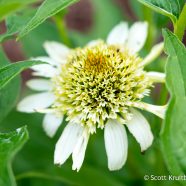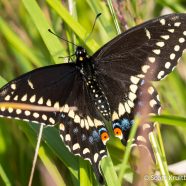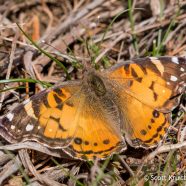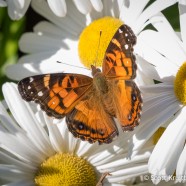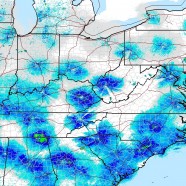Echinacea Milkshake
Earlier today RTPI Development Director Linda Pierce pointed out to me that it was National Pollinator Week, a fact that escaped my attention – like many of those national days do! Just last week I posted a couple photos of pollinator plants about to bloom for the summer. Unfortunately I have not seen too many species of butterflies or bees thus far in 2016, though I am hopeful this changes after a slow and cold start to the insect season. Coincidentally today I actually saw a couple “firsts of year” butterflies including a Red Admiral in the morning and a Giant Swallowtail...
Read MoreBlack Swallowtail
I have been on a bird tear lately, and considering it is May and this is the Roger Tory Peterson Institute of Natural History, I think it is very appropriate. However, spring is also springing for butterflies and I cannot neglect them. I found and photographed this Black Swallowtail (Papilio polyxenes) yesterday, and considering how fresh and crisp it looks the butterfly seems like it could have flown right off the pages of a Peterson Field Guide. The Clouded Sulphur, American Lady, Eastern Tailed-Blue and more are all in the air now. What species have you spotted so far this May? Scott...
Read MoreAmerican Lady Butterfly
Spring is slowly coming to Stratford Point with birds like the American Kestrel and Palm Warbler showing up in the last couple of days. Here’s an American Lady butterfly seen earlier today. We cannot wait until our gardens are full of birds, butterflies and more! It will be an exciting year.
Read MoreAmerican Lady
This American Lady (Vanessa virginiensis) butterfly still looks magnificent here in October, basking in the warm rays from the sun while feeding along with several others. It certainly has a seasonal feel with some Halloween shades, too. What a wonderful sight.
Read MoreMigration – August 12, 2015
Here is the migration map – also known as the radar of the eastern continental United States – a few hours after sunset here on August 12, 2015. Avian targets, along with undoubtedly a few insects and bats, were mostly active in the southern regions where the wind is more consistently out of the north. For those of us in the Northeast we have a flow pushing birds to the Atlantic Coast, a typical occurrence for the fall. In another month the winds will be stronger and skies will be fuller. For now you can keep expecting to find birds like Bobolink, Orchard Oriole, Northern...
Read More



